I’m writing a Twitch bot on a Raspberry Pi with Python 3. The bot uses the Twitch IRC interface interface to read and send and messages. To communicate with any of Twitches APIs, including the IRC interface, an access token is required from their OAuth server. The Twitch API is well documented, and there are excellent examples available in Node and Go. This is an example implementation using Python 3.
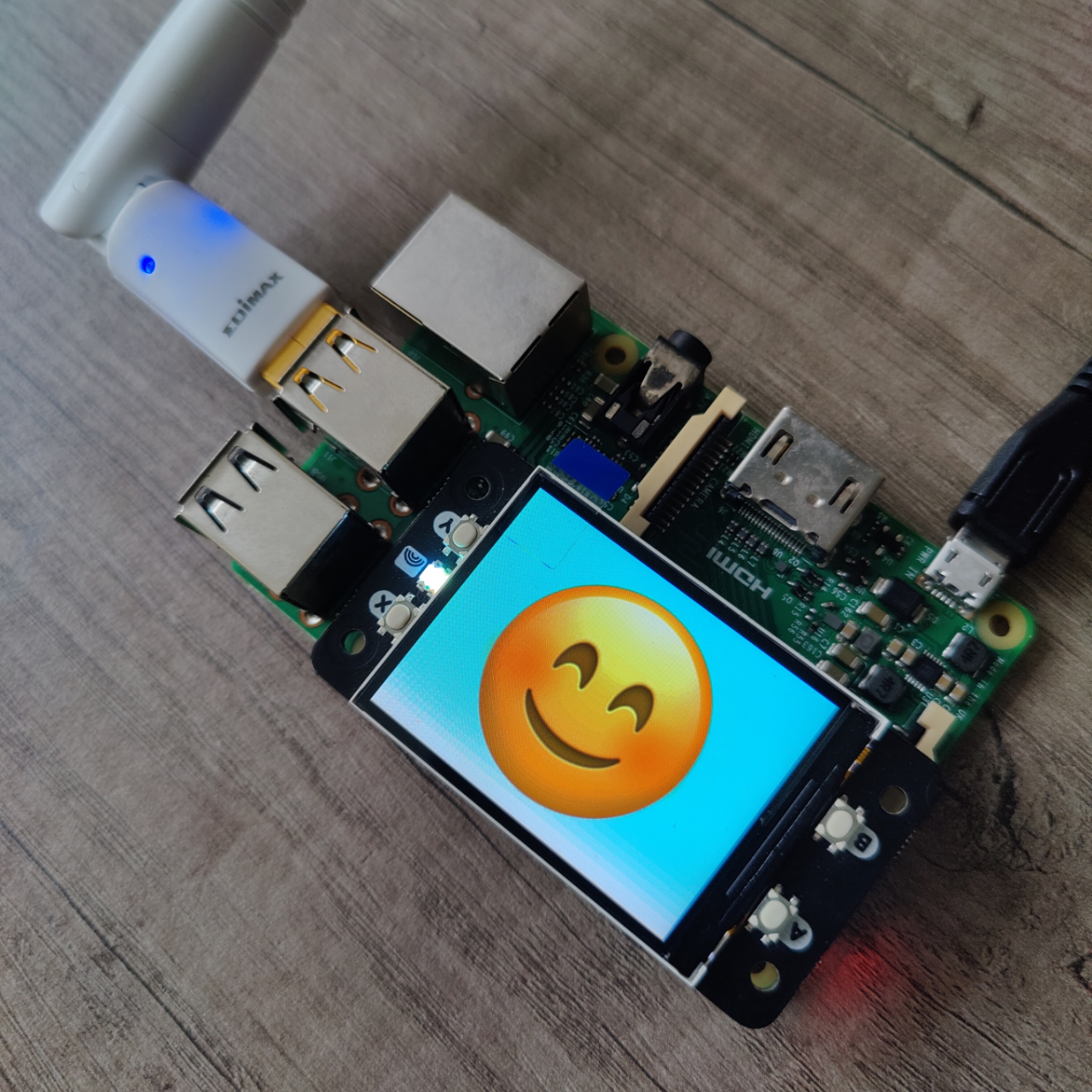
Disclaimer: This is not production ready code, and is provided as a working example only. My Python is limited to building Raspberry Pi gadgets, so I apologise for any offence in coding style I’m about to commit. I’m open to discussion and comments.
All code samples are ultimately from twitch_auth.py in PertyBot, a physical computing Twitch bot in development.
Registration on Twitch Developers
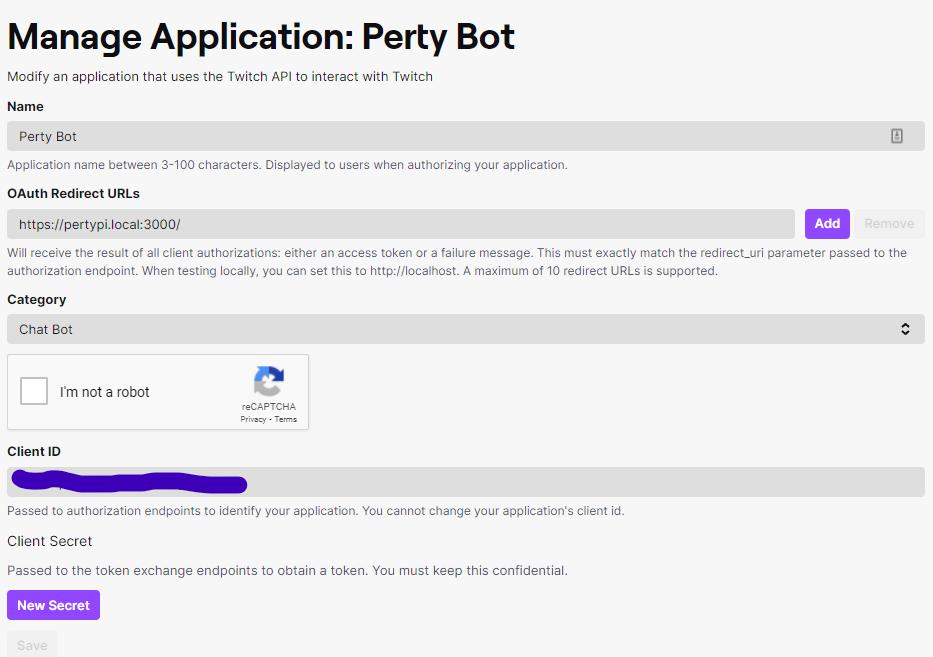
You’ll need to register an application with Twitch Developers, to obtain a client_id and client_secret. When storing these with your application, please treat them as secret and try to not to commit them with your codebase. Take a look at a .gitignore file.
Overview of Authorization Code Flow
The authorization code flow passes an authorization code from Twitch to our application. This code can then be redeemed for an access and renewal token, which we can use to access Twitch’s APIs. There’s a few steps we need to go through:
- “Get” the authorization token from Twitch
- Exchange the authorization token from an access token
- (Periodically) check the access token is still valid, if it’s no longer valid, renew.
“Get” the authorization token from Twitch
“Get” is a lie. We don’t “Get” anything. The user in the browser does the work here, and then Twitch “gives” us the authorization code back. We’re going to host a small web server, host a web page with a link to the authorization url that contains all the required properties and then prompt the user to open their browser. When the authorization with Twitch is complete, we handle the response from Twitch and store the code.
Scopes defines the permissions we’re seeking for our application. In this case, we’re looking for read and write chat permissions, so we’re only requesting chat:edit and chat:read. Request the scopes you need for your application permissions.
from http.server import BaseHTTPRequestHandler, HTTPServer
from urllib.parse import urlparse, parse_qs, urlunparse, urlencode
import ssl
host = 'localhost'
port = 3000
redirect_uri = f'https://{host}:{port}/'
code = None
class HandleRequests(BaseHTTPRequestHandler):
keep_running = True
def _set_headers(self):
self.send_response(200)
self.send_header('Content-type', 'text/html')
self.end_headers()
def do_GET(self):
global code
self._set_headers()
path = urlparse(self.path)
if not path.query:
# If there's no auth code, keep serving the web page.
request_payload = {
"client_id": client_id,
"force_verify": 'false',
"redirect_uri": redirect_uri,
"response_type": 'code',
"scope": 'chat:edit chat:read'
}
encoded_payload = urlencode(request_payload)
url = 'https://id.twitch.tv/oauth2/authorize?' + encoded_payload
self.wfile.write(f'<html><head><body><a href="{url}">Click here to auth with Twitch</a></body></head>'.encode('utf-8'))
else:
# If Twitch has provided a code, store it and stop the web server.
code = parse_qs(path.query)['code'][0]
print(f'Code: {code}')
HandleRequests.keep_running = False
# Authorisation Code Flow
# Launch HTTP Server, listen for request, direct user to Twitch,
# listen for response.
def auth_code_flow():
httpd = HTTPServer((host, port), HandleRequests)
httpd.socket = ssl.wrap_socket (httpd.socket,
keyfile="key.pem",
certfile='cert.pem', server_side=True)
print(f'Please open your browser at {redirect_uri}')
# Keep listening until we handle a post request
while HandleRequests.keep_running:
httpd.handle_request()
To run this, you’ll need a local certificate, you can generate this from the shell with openssl:
openssl req -newkey rsa:4096 -x509 -sha256 -days 3650 -nodes -out cert.pem -keyout key.pem
On running the script and opening the browser, the user should see the link to Twitch, followed by the Twitch authorization process and then a blank page. The authorization code has been handled by our application, and our web server terminated.
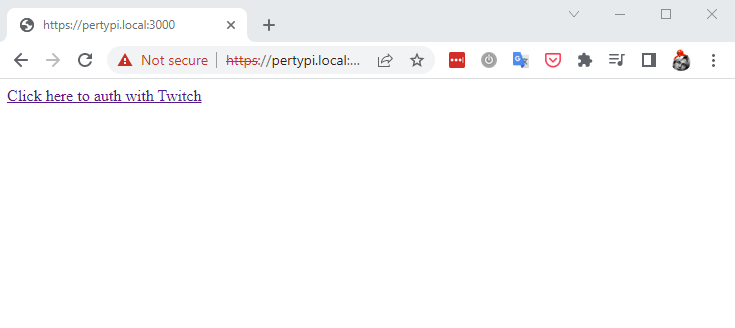
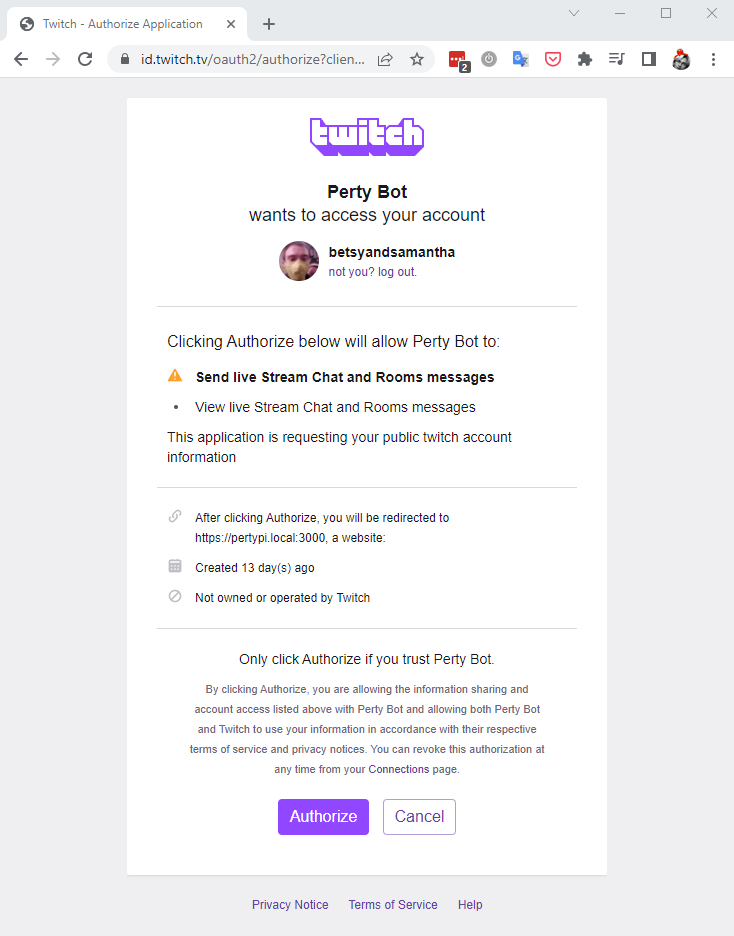
Exchange the authorization token for an access token
The authorization token is only good for one thing - getting the access token. So, we make a request to exchange our tokens.
If our request is successful, then we store our access and refresh tokens. Otherwise, we dump the response and let the user deal with it.
access_token = None
refresh_token = None
def get_tokens():
print("Fetching Twitch tokens")
global access_token
global refresh_token
url = 'https://id.twitch.tv/oauth2/token'
request_payload = {
"client_id": client_id,
"client_secret": client_secret,
"grant_type": 'authorization_code',
"code": code
'redirect_uri': redirect_uri
}
r = requests.post(url, data=request_payload).json()
try:
access_token = r['access_token']
refresh_token = r['refresh_token']
print(f'Access token: {access_token}')
print(f'Refresh token: {refresh_token}')
except:
print("Unexpected response on redeeming auth code:")
print(r)
At this point, we should have an access token that we can use to auth our application with Twitch - here’s a quick example connecting to Twitch IRC:
import socket
sock = socket.socket()
sock.connect(('irc.chat.twitch.tv', 6667))
sock.send(f"PASS oauth:{access_token}\n".encode('utf-8'))
sock.send(f"NICK twitchname\n".encode('utf-8'))
sock.send(f"JOIN #mypopulartwitchchannel\n".encode('utf-8'))
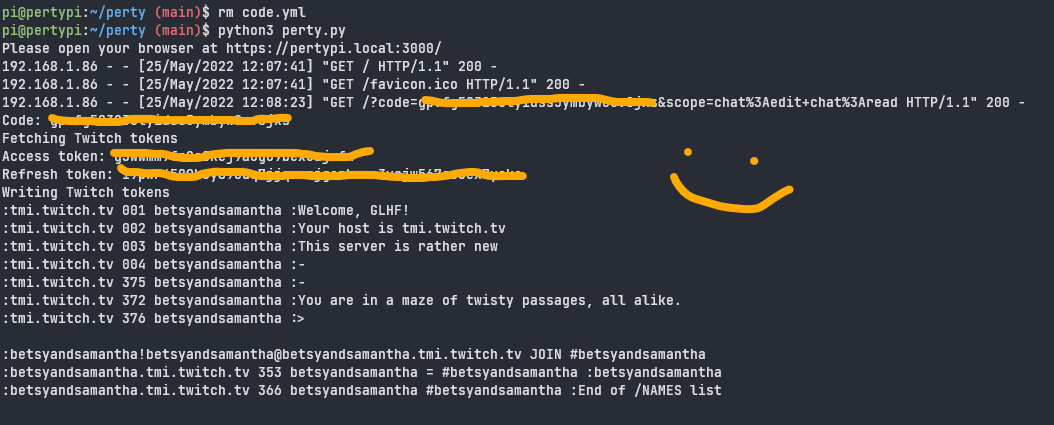
Validating The Access Token
The access token is only valid for a given period of time in the expires_in property. However, the token can be expired for any number of reasons, so Twitch recommend that tokens are validated before use.
Twitch provides an endpoint for validating tokens. Pass the token in an authentication header to the endpoint, and the status code reflects the token condition. 200 - OK, 401 - invalid and requires renewal.
Important - Twitch also requires that you check the validity of your token hourly, regardless of expiration time, and if validation fails, force the application to acquire a new access token. Twitch will block your application if it can not detect this behaviour on audit.
def validate():
print("Validating Twitch tokens...", end='')
url = 'https://id.twitch.tv/oauth2/validate'
r = requests.get(url, headers={'Authorization': f'Oauth {access_token}'})
if r.status_code == 200:
print("valid")
return True
elif r.status_code == 401:
print("invalid")
return False
else:
raise Exception(f'Unrecognised status code on validate {r.status_code}')
Refresh the Access Token
If the access token is expired, it will need to be refreshed. We can adapt our get_tokens() method to handle the original authorization code exchange, or the refresh_token exchange:
def get_tokens():
print("Fetching Twitch tokens")
global access_token
global refresh_token
url = 'https://id.twitch.tv/oauth2/token'
request_payload = {
"client_id": client_id,
"client_secret": client_secret,
'redirect_uri': redirect_uri
}
if code:
request_payload['grant_type'] = 'authorization_code'
request_payload['code'] = code
elif refresh_token:
request_payload['grant_type'] = 'refresh_token'
request_payload['refresh_token'] = refresh_token
else:
raise Exception('No code or refresh_token to exchange')
r = requests.post(url, data=request_payload).json()
try:
access_token = r['access_token']
refresh_token = r['refresh_token']
print(f'Access token: {access_token}')
print(f'Refresh token: {refresh_token}')
except:
print("Unexpected response on redeeming auth code:")
print(r)
All together
Putting it together we can write a handler that will handle our entire authorization code flow:
def oauth():
if read_code(): # read access_token and refresh_token from config
if not validate(): # is access token valid?
get_tokens() # refresh access token
else:
auth_code_flow() # interactive auth code flow
get_tokens() # exchange auth token for access token
write_code() # write access_token and refresh_token to config
return access_token # return access token back to application
The user will only be promoted to authorize with Twitch if they are needed to do so, otherwise we will use the existing access token, or refresh the token first.
 There are no ads on this blog and as far as I can remember, never have been.
There are no ads on this blog and as far as I can remember, never have been.